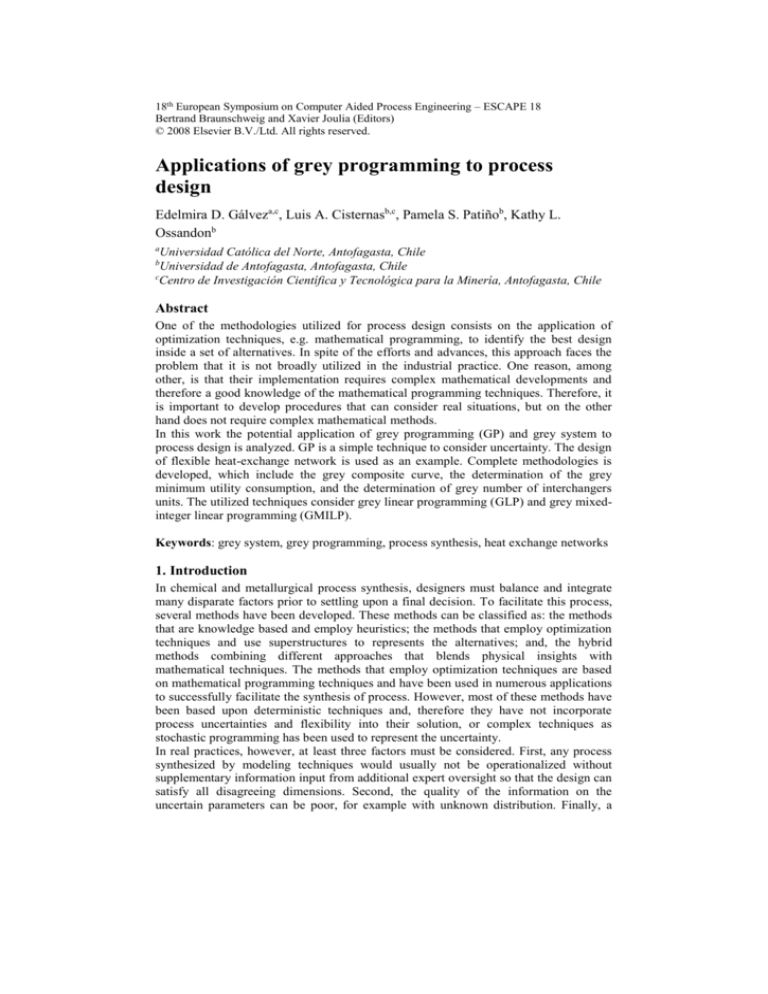
18th European Symposium on Computer Aided Process Engineering – ESCAPE 18
Bertrand Braunschweig and Xavier Joulia (Editors)
© 2008 Elsevier B.V./Ltd. All rights reserved.
Applications of grey programming to process
design
Edelmira D. Gálveza,c, Luis A. Cisternasb,c, Pamela S. Patiñob, Kathy L.
Ossandonb
a
Universidad Católica del Norte, Antofagasta, Chile
Universidad de Antofagasta, Antofagasta, Chile
c
Centro de Investigación Científica y Tecnológica para la Minería, Antofagasta, Chile
b
Abstract
One of the methodologies utilized for process design consists on the application of
optimization techniques, e.g. mathematical programming, to identify the best design
inside a set of alternatives. In spite of the efforts and advances, this approach faces the
problem that it is not broadly utilized in the industrial practice. One reason, among
other, is that their implementation requires complex mathematical developments and
therefore a good knowledge of the mathematical programming techniques. Therefore, it
is important to develop procedures that can consider real situations, but on the other
hand does not require complex mathematical methods.
In this work the potential application of grey programming (GP) and grey system to
process design is analyzed. GP is a simple technique to consider uncertainty. The design
of flexible heat-exchange network is used as an example. Complete methodologies is
developed, which include the grey composite curve, the determination of the grey
minimum utility consumption, and the determination of grey number of interchangers
units. The utilized techniques consider grey linear programming (GLP) and grey mixedinteger linear programming (GMILP).
Keywords: grey system, grey programming, process synthesis, heat exchange networks
1. Introduction
In chemical and metallurgical process synthesis, designers must balance and integrate
many disparate factors prior to settling upon a final decision. To facilitate this process,
several methods have been developed. These methods can be classified as: the methods
that are knowledge based and employ heuristics; the methods that employ optimization
techniques and use superstructures to represents the alternatives; and, the hybrid
methods combining different approaches that blends physical insights with
mathematical techniques. The methods that employ optimization techniques are based
on mathematical programming techniques and have been used in numerous applications
to successfully facilitate the synthesis of process. However, most of these methods have
been based upon deterministic techniques and, therefore they have not incorporate
process uncertainties and flexibility into their solution, or complex techniques as
stochastic programming has been used to represent the uncertainty.
In real practices, however, at least three factors must be considered. First, any process
synthesized by modeling techniques would usually not be operationalized without
supplementary information input from additional expert oversight so that the design can
satisfy all disagreeing dimensions. Second, the quality of the information on the
uncertain parameters can be poor, for example with unknown distribution. Finally, a
2
E. Gálvez & L. Cisternas
complex technique as stochastic programming requires efficient numerical solvers and a
good knowledge of the techniques which can be an important restriction. Grey theory
(GT) [1] can mitigate the above troubles because 1) GT will not conduct to more
complicated models, and thus will be more easy to understand and use and will have
lower computational requirements compared with other techniques, 2) GT will not
require distribution information for the uncertain parameters and therefore it will be
more easy for designers to define the uncertainty, 3) GT will provide feasible ranges for
the decision variables simplifying the decision maker.
In this work, GT is applied to process synthesis, specifically to the synthesis of heat
exchange network (HEN).
2. Background
In this section, we first introduce some useful information on GS and GP, and then
provide some basic information on HEN.
2.1. Grey Systems
Each GS is described with grey numbers, grey equations, grey matrices, etc. A grey
number is such a number whose exact value is unknown but a range within that the
value lies is known, this is a grey number x± is defined as un interval with known upper
and lower bounds but unknown distribution information for x,
x x , x t x | x t x
(1)
Where x- and x+ are the lower and upper bounds of x± respectively, when x-=x+, x± turn
into a deterministic number. For grey numbers x± and y±, we have
x y min( x y), max( x y) ,
(2)
Where x x x , y y y and ,,, is a binary operation on grey
numbers [1]
The whitened value of a grey number, x±, is a deterministic number with its value
remaining between the upper and lower bounds of x±. A grey integer number is a grey
number with integer upper and lower bounds, and all its whitened values are integers.
A grey mixed-integer linear programming (GMILP) model is formulated by introducing
concepts of GS into a mixed integer linear programming modeling framework as
follows[2]
max f C X
s .t .
A X B
(3)
Where X± is a vector of grey continuous and grey integer variables, A± {R±}m×n, B±
{R±}m×1, (where R± stand for a set of grey numbers) and f± is a grey objective function.
GMILP provides feasible ranges for the decision variables which are useful for decision
makers to validate the generated alternatives. The solution of the grey binary variables
have four possible presentation ([0,0], [1,1], [0,1], and [1,0]). They can be interpreted as
grey decisions alternatives, reflecting potential system condition variations caused by
the uncertainties.
2.2. Heat Exchange Network
Grey systems and grey programming are easy to apply, and therefore it can be applied
to many problems, for example heat exchange network (HEN). The synthesis of HEN is
Applications of grey programming to process design
3
one of the extensively studied problems in chemical engineering, where the objective is
the generation of a network of heat exchangers either with minimum total utility
consumption, minimum number of heat-transfer units, or minimum total cost. The
methods for the synthesis of HEN can be classified as heuristic-algorithmicevolutionary and mathematical-programming [3]. Usually in these methods nominal
parameters values are used, e.g. constant values for source-heat-capacity-flowrates and
temperatures. The problem of including uncertainties in these parameters in the
synthesis of HEN´s has started to receive attention over the last years. Several works
have been published on flexible HEN including MILP transshipment model with the
active set strategy to guarantee the desired HEN flexibility [4, 5].
A simple way to synthesize HEN is the transshipment model, which solve the problem
using sequential optimization. In this strategy the minimum utility consumption is
determined first by means of a LP model, and based on these results the minimum
number of matches is determined using a MILP model [6].
3. Grey heat integration
3.1. Grey heat Exchanger Network
Pinch analysis is a methodology that allows the calculation of minimum hot and cold
utilities consumptions in a process from the knowledge of some data of the hot and cold
streams. This methodology is well known in the literature and it based in the calculation
of cascade composite hot and cold heat flows [6] based on initial and final temperatures
stream and its mean heat capacity flowrate. Let denote Ch { (T , Q) | Q FCP (Tin T ),
Tout T Tin } as the Hohmann/Lockhart curve for a hot stream h, then the hot composite
curve can be defined as CCH Ch where represents the composition of one curve
hH
based on the set of Ch, and H denotes the set of hot streams. A similar definition is
possible for the cold streams, this is CC { (T , Q) | Q FCP (T Tin ), Tin T Tout } and
CCC CC where C denotes the set of cold streams.
cC
Then the grey hot Hohmann/Lockhart curve can be defined as CH CH , CH where
Ch { (T , Q ) | Q FCP (Tin T ), Tout
T Tin } , i.e. CH { (T , Q ) | Q FCP (Tin T ),
Tout
T Tin } and CH { (T , Q ) | Q FCP (Tin T ),
definitions the grey hot composite curve is
Tout
T Tin } . Based in these
GCCH Ch
hH
GCCH , GCCH
Ch , Ch . In the same way, the grey cold Hohmann/Lockhart curve is
hH
hH
Cc { (T , Q ) | Q FCP (T Tin ), Tin T Tout
CC CC , CC
where
i.e.
},
CC { (T , Q ) | Q FCP (T Tin ), Tin T Tout
} and CC { (T , Q ) | Q FCP (T Tin ),
Tin T Tout
} . Subsequently the grey cold composite curve is
GCC , GCC Cc , Cc .
cC
cC
C
C
GCCC Cc
cC
Also, it is possible to calculate the grey grand
composite curve, which can be very useful to analyze the heat integration problem
under uncertain parameters.
As an example, for process streams presented in table 1, we can calculate the GCCH and
GCCC as it is shown in Fig. 1. This problem is a modification of the example 16.1
presented in [6], with steam available at 500ºC, cooling water 20-30ºC, and minimum
grey recovery approach temperature of [10,10] ºC. This mean that the approach
4
E. Gálvez & L. Cisternas
temperature, for this example, is a deterministic number. For the calculation of grey
minimum hot and cold utilities consumptions ( QS and QW ) we need to integrate the
GCCH with GCCC to determine
QS and
QW , and integrate
GCCH
with GCCC to
determine QS and QW . Also to determine the grey possible heat integration, QI , we
need to integrate the GCCH with GCCC to determine QI , and GCCH with GCCC to
determine QI .
Table 1. Process data adapted from example 16.1 presented in [6]
Stream
FCP ( MW / C )
Tin (C )
Tout
(C )
H1
[0.97,1.03]
[388.0,412.0]
[116.4,123.6]
H2
[1.94,2.06]
[329.8,350.2]
[116.4,123.6]
C1
[1.46,1.55]
[155.2,164.8]
[388.0,412.0]
C2
[1.26,1.34]
[97.0,103.0]
[242.5,257.5]
440
Grey Hot Composite Curve +
390
Grey Hot Composite Curve Grey Cold Composite Curve Grey Cold Composite Curve -
T (ºC)
340
290
240
190
140
90
40
0
200
400
600
800
Cascade Heat, kW
Figure 1. Grey hot and cold composite curves
3.2. Grey transshipment model for HEN
The transshipment model for the calculation of the minimum utility consumption and
the minimum number of units can be applied using GP to consider the uncertainty in the
temperatures and the heat capacity flowrate. For example, the heat contents of the hot
and cold processing stream can be calculated considering grey temperature intervals,
which are based on the inlet and outlet temperatures and in the grey approach
temperature. Table 2 shows the grey heat contents (MW) for our example. In this work
the transshipment model proposed by Papoulias and Grossmann[7] is used. The
mathematical models are the same models proposed in [7], but grey numbers are used in
heat contents in each interval. For example the GLP transshipment model for minimum
utility consumption is:
Applications of grey programming to process design
5
min Z m QSm n QWn
s.t. Rk Rk1 m QSm n QWn iH QH i ,k iC QCi ,k k 1...K
k
k
Sm
Wn
0
(4)
k
K
R 0 Q 0 Q 0 R 0 R 0
The grey mathematical programming problem is solved in two steps, first
GCCH with GCCC are used to determine QS and QW , and then GCCH with GCCC to
determine QS and QW . Also, it is possible to calculate the grey heat integration in two
steps, first GCCH with GCCC are used to determine QI , and then GCCH with GCCC to
determine QI . All problems are LP, and therefore easy to calculate. After the
calculation of grey minimum hot and cold utilities consumptions ( QS and QW ) we can
calculate the grey fewest number of units in the network using the MILP transshipment
model proposed by Papoulias and Grossmann [7], but with GS which transforms the
problem into a GMILP transshipment model. To define the subnetworks, a grey pinch
point can be identified if a grey residual, Rk has the lower bound equal to cero.
Table 2. Grey temperature intervals and grey heat contents (MW)
Grey Temperature Intervals
Grey Heat Contents (MW)
Interval
Hot
Cold
H1
H2
C1
C2
1
[398.0,422.0 ] [388.0,412.0 ] [9.7,10.30 ]
[0.0,52.53 ]
2
[ 388.0,412.0] [ 378.0,402.0] [ 56.45,63.65]
[ 69.55,89.92]
3
[ 329.8,350.2] [ 319.8,340.2] [ 74.98,85.18] [149.96,170.36 ] [ 120.33,119.43]
4
[ 252.5,267.5] [ 242.5,257.5] [ 84.68,95.48] [ 169.36,190.96] [ 134.88,134.88] [97.98,136.98 ]
5
[ 165.2,174.8] [ 155.2,164.8] [40.35,60.15] [ 80.7,120.30]
[64.56,65.34 ]
6
[ 116.4,123.6] [ 106.4,113.6]
[ 13.37,12.59]
[107.0,113.0 ] [ 97.0,103.0]
Table 3 contains the computational results obtained through the GLP and GMILP
models. It is point out that solution for the objective function values and decision
variables are grey numbers. The GLP model gives grey numbers for the hot and cold
utilities, with a grey pinch in interval 2 ( R2 0, 4.4 ). The GMILP model, for the
minimum number of matches, gives a grey optima function equal to [5, 6]. Note that if
the solution of grey binary number are [0,0] or [1,1] then the grey binary number is a
deterministic number, meaning that the match cannot or can be adopted with certainty.
This is the case for matches H1.C1 (above and below pinch), H2.C1, H2.C2 and
H2.CW below pinch. On the other hand, the [0,1] and [1,0] solutions represent grey
decisions and can provide decision alternatives according with the desired flexibility of
the network. This is the case for matches ST.C1 above pinch, H1.C2 and H1.CW below
pinch. Thus, decision alternatives can be generated by adjusting/shifting the grey
number solutions within their solution intervals according to the operational conditions.
6
E. Gálvez & L. Cisternas
Table 3. Results to example of table 1
Grey minimum hot and cold utilities
Grey Matches
QS =[0,76.3]
QW =[130.81,295.71]
Above pinch
yH 1,C1 [1,1]
yST
, C 1 [1,0]
Below pinch
yH 1, C 2 [1,0]
yH 2, C1 [1,1]
yH 2, CW [1,1]
yH 1,CW [0,1]
yH 1,C1 [1,1]
yH 2,C 2 [1,1]
4. Conclusions
Grey systems and grey programming methods have been applied to the synthesis of heat
exchange network. It improves upon other existing deterministic methods by allowing
uncertain information to be directly considered into the synthesis/optimization process,
and improves upon other no-deterministic methods by simplifying the mathematical
problem. The results indicate that reasonable solutions have been generated for both
continuous and binary variables. The grey system can be easy applied to other
problems like mass exchange networks.
Acknowledgments
The authors wish to thank CONICYT for support through Fondecyt Project 1060342.
References
[1] S. Liu and Y. Lin, Grey Information, Springer, USA, 2006
[2] G.H. Huang, B.W. Beatz, G.G. Patry, 1995, Grey integer programming: An application to
waste management planning under uncertainty, European Journal of operational Research, 83,
594-620.
[3]A.E. Konukman, M.C. Camurdan, U. Akman, 2002, Simultaneous flexibility targeting and
synthesis of minimum-utility heat-exchanger networks with superstructure-based MILP
formulation, Chemical Engineering and Processing, 41, 501-518.
[4] C.A. Floudas, I.E. Grossmann, 1986, automatic synthesis of optimum heat exchanger network
configurations, AIChE J., 32, 276.
[5] C.L. Chen, P.S. Hung, 2007, Synthesis of flexible heat exchange networks and mass exchange
networks, Computers and Chemical Engineering, 31, 1619-1632.
[6] L.T. Biegler, I.E. Grossmann, A.W. Westerberg, 1997, systematic methods of chemical
process design, Prentice Hall.
[7] S.A. Papoulias, I.E. Grossmann, 1983, A structural optimization approach to process
synthesis-II. Heat recovery networks. Computer and Chemical Engineering, 8, 707.







